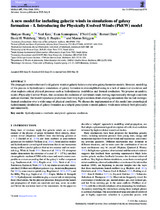| dc.contributor.author | Dave, Romeel | |
| dc.contributor.author | Huang, Shuiyao | |
| dc.contributor.author | Katz, Neal | |
| dc.date.accessioned | 2021-02-09T09:58:59Z | |
| dc.date.available | 2021-02-09T09:58:59Z | |
| dc.date.issued | 2020-07-08 | |
| dc.identifier.citation | Dave, R; Huang, S; Katz, N. 2020. A new model for including galactic winds in simulations of galaxy formation – I. Introducing the Physically Evolved Winds (PhEW) model. Monthly Notices of the Royal Astronomical Society. 497(3):2586-2604 | en_US |
| dc.identifier.uri | :10.1093/mnras/staa1978 | |
| dc.identifier.uri | http://hdl.handle.net/10566/5873 | |
| dc.description.abstract | The propagation and evolution of cold galactic winds in galactic haloes is crucial to galaxy formation models. However, modelling
of this process in hydrodynamic simulations of galaxy formation is oversimplified owing to a lack of numerical resolution and
often neglects critical physical processes such as hydrodynamic instabilities and thermal conduction. We propose an analytic
model, Physically Evolved Winds, that calculates the evolution of individual clouds moving supersonically through a uniform
ambient medium. Our model reproduces predictions from very high resolution cloud-crushing simulations that include isotropic
thermal conduction over a wide range of physical conditions. We discuss the implementation of this model into cosmological
hydrodynamic simulations of galaxy formation as a subgrid prescription to model galactic winds more robustly both physically
and numerically. | en_US |
| dc.language.iso | en | en_US |
| dc.publisher | Oxford University Press | en_US |
| dc.subject | galaxies: evolution. | en_US |
| dc.subject | methods: analytical | en_US |
| dc.subject | hydrodynamics | en_US |
| dc.title | A new model for including galactic winds in simulations of galaxy formation – I. Introducing the Physically Evolved Winds (PhEW) model | en_US |
| dc.type | Article | en_US |

